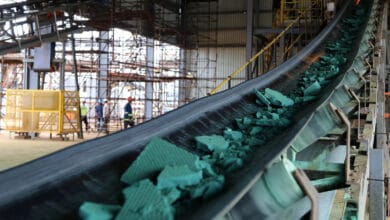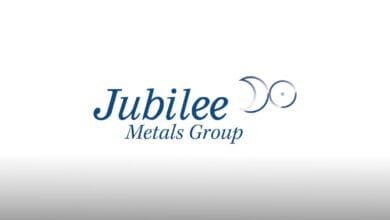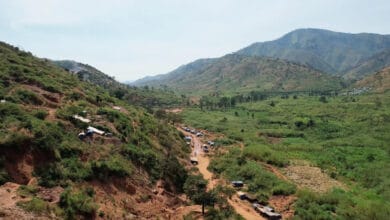Perseus Mining has uncovered promising high-grade gold intercepts at its Nyanzaga project in Tanzania, suggesting significant potential to extend the mine’s operational lifespan beyond the initially planned 11 years. The ongoing exploration program has delivered exceptional results that could transform the project’s economics and longevity.
Recent drilling has returned remarkable intercepts including 54 meters at 9.69 grams per tonne (g/t), 84 meters at 3.24 g/t, and an impressive 23 meters at 20.87 g/t gold – findings that rank among the global top 10% of 2025 gold price analysis. These results significantly exceed industry averages for open-pit operations, which typically range from 0.5-5 g/t.
The high-grade zones discovered below the currently planned open pit are particularly promising, as Perseus Mining‘s Managing Director and CEO Jeff Quartermaine noted: “Of particular interest to us are the excellent drill results achieved as part of the current drill program at depths below the bottom of the currently envisaged large open pit. While more drilling is required to confirm extensions of mineralization at depth, the early indications suggest further exploitation of the mineralization, including the potential for application of underground mining methods, may be possible resulting in a further extension of the mine life.”
What makes the Nyanzaga drilling results significant?
◆ Impressive high-grade intercepts
The recent drilling campaign at the Tusker and Kilimani deposits has yielded gold concentrations that substantially exceed industry averages:
- 54 meters at 9.69 g/t gold – nearly double the grade needed for economic underground mining
- 84 meters at 3.24 g/t gold – exceptional width providing bulk mining potential
- 23 meters at 20.87 g/t gold – ultra-high grade that could transform project economics
These results are particularly significant when compared to the global average open-pit gold mine grade of approximately 1-2 g/t, placing Nyanzaga in an elite category of high-grade gold deposits analysis in East Africa.
◆ Strategic resource definition program
The current drilling results form part of Perseus Mining’s comprehensive second phase of resource definition drilling, specifically designed to:
- Update the project’s mineral resource estimates with higher geological confidence
- Refine ore reserve calculations to optimise extraction sequencing
- Enhance mining plans to maximise economic returns
- Validate the potential for underground mining operations
This methodical approach demonstrates Perseus’s commitment to unlocking the full value of the Nyanzaga asset through rigorous technical evaluation.
◆ Deep mineralization potential
Perhaps most significantly, the drilling program has identified promising mineralization at depths extending well below the currently planned open pit, suggesting:
- Potential for underground mining methods to access high-value ore zones
- Vertical extension of the resource that could add several years to mine life
- Opportunities for operational expansion beyond the initial 11-year projection
- Possible transition from open-pit to underground mining as the project matures
“The discovery of substantial mineralization below the planned pit floor represents a potential game-changer for Nyanzaga’s economic model, as it opens pathways to a hybrid mining approach that could significantly extend productive operations.” Analysis based on Perseus Mining’s technical assessment
How is Perseus advancing the Nyanzaga project?
◆ Comprehensive drilling campaign
Since acquiring Nyanzaga in April 2025, Perseus has made remarkable progress with its exploration and development program:
- Completed 58,609 meters of drilling across multiple target zones
- Focused primarily on the Tusker and Kilimani deposits, the project’s primary ore bodies
- Conducted systematic infill drilling to improve geological confidence
- Tightened drill spacing for more accurate resource modeling and grade estimation
- Tested extensions to known mineralization both laterally and at depth
This aggressive drilling campaign demonstrates Perseus’s commitment to rapidly advancing the project while maximising its resource potential.
◆ Ongoing technical studies
In parallel with the resource drilling, Perseus is conducting a suite of specialised technical studies to de-risk the project:
- Geotechnical drilling to assess ground conditions for both open pit and potential underground operations
- Metallurgical testing to optimise processing methods and maximise gold recovery rates
- Sterilisation drilling in planned infrastructure areas to ensure no valuable resources are covered
- Hydrogeological assessment to understand groundwater conditions and dewatering requirements
These concurrent workstreams are scheduled for completion by December 2025, creating a comprehensive technical foundation for the final investment decision.
◆ Timeline to production
Perseus has established a clear and achievable development pathway for Nyanzaga:
- Completion of all technical studies by December 2025
- Updated ore reserve statement expected in Q1 2026
- Engineering design and construction throughout 2026
- First gold production targeted for January 2027
This timeline balances the need for thorough technical evaluation with commercial imperatives to bring the asset into production efficiently.
What Is the current resource base at Nyanzaga?
◆ Substantial gold inventory
The Nyanzaga project currently hosts a significant gold endowment:
- 3.2 million ounces of gold in Indicated Mineral Resources
- 2.3 million ounces of gold in Probable Ore Reserves
This resource base already positions Nyanzaga as one of Tanzania’s most substantial gold development projects, even before accounting for the potential extensions identified in recent drilling.
| Resource Category | Million Ounces | Average Grade (g/t) |
|---|---|---|
| Indicated Resources | 3.2 | Not specified in source |
| Probable Reserves | 2.3 | Not specified in source |
Note: The recent drill results suggest potential for resource growth beyond these figures.
◆ Strategic location
The project is advantageously situated in northwestern Tanzania, a region with:
- Established mining infrastructure and supply chains
- Favorable geological setting within the Lake Victoria Goldfields
- Access to skilled workforce with experience in gold mining operations
- Proximity to other major gold mines like Geita (5Moz reserves) and Bulyanhulu (2.2Moz)
This strategic positioning enhances the project’s development potential while potentially reducing capital requirements for infrastructure.
What does this mean for Perseus Mining’s future?
◆ Management perspective
Perseus Managing Director and CEO Jeff Quartermaine has expressed confidence in the project’s expansion potential, noting that the excellent drill results reinforce the company’s growth strategy. The discovery of deep mineralization presents particularly exciting opportunities that could transform the project’s long-term outlook.
While more drilling is required to confirm the full extent of mineralization at depth, the early indications point to potential application of underground mining methods that could substantially extend Nyanzaga’s productive life.
◆ Investment implications
The positive drilling results could significantly impact Perseus Mining’s outlook through multiple avenues:
- Extended mine life beyond the initial 11-year plan, potentially adding 5+ years of production
- Potential for increased production capacity through simultaneous open-pit and underground operations
- Enhanced project economics and return on investment from accessing higher-grade underground material
- Strengthened position in the gold mining sector as a mid-tier producer with growth potential
For investors, the Nyanzaga project represents Perseus’s commitment to building a sustainable production profile with multiple operating assets across Africa. The company’s disciplined approach to resource development and operational excellence positions it well to capitalize on the project’s emerging potential.
How could underground mining transform the project?
◆ Operational flexibility
The identification of deep, high-grade mineralization opens possibilities for a more dynamic mining approach:
- Combined open-pit and underground mining to optimise extraction of different ore zones
- Sequential development phases starting with open pit and transitioning to underground
- Optimised extraction sequencing to prioritise high-margin material
- Extended processing plant life through sustained ore feed from multiple sources
This operational flexibility would allow Perseus to adapt its mining strategy in response to changing economic conditions and mineral exploration insights throughout the project’s life.
◆ Economic considerations
Underground mining at Nyanzaga could deliver several economic advantages:
- Access to higher-grade material at depth that might be uneconomic to extract via open pit
- Extended production timeline potentially adding 5+ years beyond the initial plan
- More sustainable long-term operations with reduced waste-to-ore ratios in later years
- Reduced surface footprint compared to an expanded open pit, minimising environmental impact
- Optimised capital efficiency through staged development approach
The financial implications of transitioning to underground mining would depend on several factors, including:
- Grade distribution at depth
- Underground mining costs (typically US$70-US$100 per tonne versus US$20-US$40 for open pit)
- Gold price outlook
- Processing recoveries from deeper ore zones
A hybrid approach could potentially deliver the best of both worlds: efficient bulk mining via open pit for near-surface resources, followed by selective high-grade underground mining for deeper zones.
What’s next for the Nyanzaga gold project?
◆ Near-term milestones
Key upcoming developments in Nyanzaga’s advancement include:
- Completion of current drilling programs by December 2025
- Updated mineral resource estimate incorporating all new drilling data
- Revised ore reserve calculation in Q1 2026, defining the initial mining inventory
- Advancement of project engineering and design for both open pit and potential underground components
- Final investment decision following comprehensive technical and economic assessment
These milestones will provide increasing clarity on the project’s scope, economics, and development timeline.
◆ Production timeline
Perseus remains on track to deliver Nyanzaga as Tanzania’s next major gold mine:
- Project construction throughout 2026, including processing plant and infrastructure
- First gold production in January 2027, marking Perseus’s entry into Tanzania
- Potential for expanded operations based on the promising drilling results at depth
The company’s track record of successful mine development in West Africa positions it well to execute on this timeline, though regulatory approvals and construction logistics will be critical path items to monitor.
◆ Regulatory and community considerations
As Perseus advances Nyanzaga toward production, several non-technical factors will influence the project’s development:
- Tanzanian mining regulations and compliance with the country’s mining code
- Community engagement and social license to operate
- Environmental permitting for both open-pit and potential underground operations
- Local workforce development to maximise Tanzanian participation
Perseus’s approach to these aspects will be crucial in ensuring the project’s long-term success and acceptance within Tanzania.









